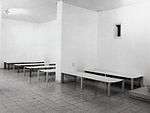Nahum Tevet
| Nahum Tevet | |
|---|---|
 Photograph of Nahum Tevet | |
| Born |
1946 Kibbutz Mesilot, Israel |
| Nationality | Israeli, Jewish |
| Education | Avni Institute of Art and Design, Tel Aviv |
| Known for | Sculpture |
| Movement | Israeli art |
Nahum Tevet (Hebrew: נחום טבת) is an Israeli sculptor. Tevet's conceptual work uses minimalism and other references (such as Bauhaus), creating sculptural/architectural installations based on geometrical modules.[1]
Biography
Nahum Tevet was born in 1946, in Kibbutz Mesilot, Israel.[2] He lives and works in Tel Aviv. In 1962, he studied at the Oranim Seminar in Kiryat Tiv'on. In 1968, he attended the Avni Institute of Art and Design in Tel Aviv. In 1969-1971, he studied with Raffi Lavie.
Artistic career
Nahum Tevet was the most extreme of the Israeli Minimalists in the mid-1970s. He saw creativity as a process based on a system of abstentions and reductions; the aim of the creative process being to impart the essence of the plastic medium. However, at least two qualities in his work break the rules of Minimalism: the lyric quality of his color and line, and the frequent resemblance of his works to real objects, like tables or beds. This utilitarian element was later to be developed in sculpture in the West.
Teaching career
In 1980 Nachum Tevet was appointed to the faculty of the Bezalel Academy of Arts and Design in Jerusalem and served as director of its M.F.A. program for the years 2001-2010.[3]
Gallery
 Arrangement of Six Units, 1973-74
Arrangement of Six Units, 1973-74 Corner, 1974
Corner, 1974
Tel Aviv Museum of Art Collection Narcissus, 1982
Narcissus, 1982 Jemmáin, 1986
Jemmáin, 1986
Kunsthalle Mannheim Collection Painting Lesson, no 5, 1986
Painting Lesson, no 5, 1986
Israel Museum Collection Underground Event, 1997
Underground Event, 1997
Glaskasten Sculpture Museum, Marl Collection Several Things, 2008
Several Things, 2008 At the Same Time, 2010
At the Same Time, 2010
Awards and recognition
- 1973-76 Young Artist Scholarships, America-Israel Cultual Foundation
- 1979-80 Scholarship for study in New York, America-Israel Cultual Foundation
- 1984 Bank Discount Prize, Tel Aviv Museum
- 1986 Sandberg Prize, Israel Museum, Jerusalem
- 1990 America-Israel Cultural Foundation
- 1991 Fondek Prize, Tel Aviv Museum of Art
- 1992 Minister of Education and Culture Prize for an Israeli Artist
- 2007 Life Achievement Award, Ministry of Science, Culture and Sport
- 2011 Dizengoff Prize for Painting and Sculpture, Tel Aviv- Jaffa
Selected exhibitions
- 1976 Israel Museum, Jerusalem.
- 1984 Israel Museum, Jerusalem.
- 1995 Städtische Gal. am Buntentor, Bremen
- 1991 Tel Aviv Museum.
- 1987 "Documenta 8", Cassel.
- 1982 Israel Museum, Jerusalem.
- 1984 Israel Museum, Jerusalem.
- 1985 Israel Museum, Jerusalem.
- 1990 Israel Museum, Jerusalem.
- 2004 "Seven Walks", Dundee Contemporary Art, Dundee, Scotland.
- 2013 "Israel Now, Reinventing the Future", Macro Museum, Rome
References
- ↑ "Artis: Artist Profiles: Nahum Tevet". Artiscontemporary.org. Retrieved 2011-09-21.
- ↑ "Nahum Tevet". Information Center for Israeli Art. Israel Museum. Retrieved August 14, 2011.
- ↑ Bezalel Academy news item on Prof. Nahum Tevet, 2 Nov. 2011
External links
- Nahum Tevet collection at the Israel Museum. Retrieved January 22, 2012
- "Nahum Tevet". Information Center for Israeli Art. Israel Museum. Retrieved January 22, 2012.
- Art of Nahum Tevet at Europeana. Retrieved January 22, 2012